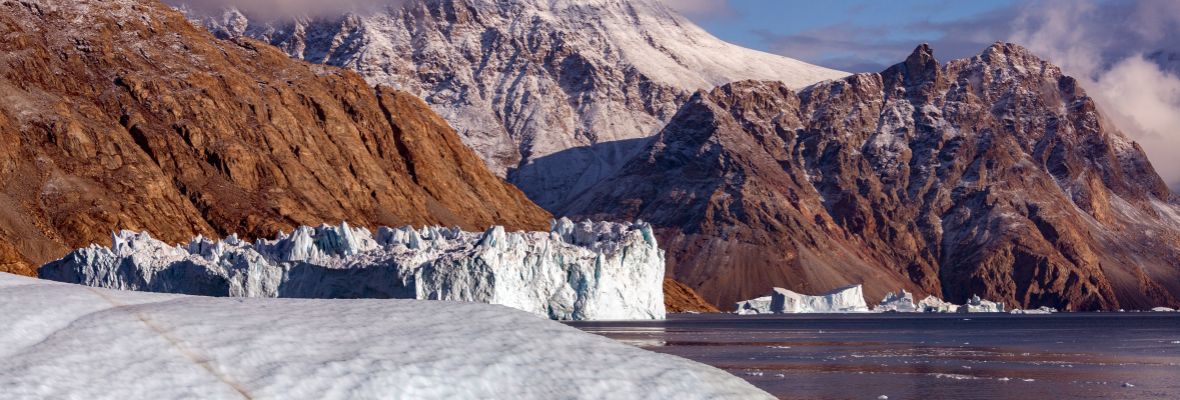Through the Greenland Sea
Next DepartureSep. 15, 2026See all departures |
Duration12 daysSee the itinerary |
Activities |
Experience the best of the Arctic Autumn on a thrilling voyage from Svalbard to East Greenland and Iceland. Watch the Arctic waters for whales, experience untouched nature and witness the breathtaking Northern Lights. From the frosts of Svalbard to the jaw-dropping mountains of Greenland and the volcanic landscapes of Iceland, experience the best of the Arctic in one thrilling voyage!
Our thrilling voyage in the Greenland Sea combines the best of the Arctic, exploring the frosty shores of Svalbard, the magnificent fjords of East Greenland and the warm hospitality and geological marvels of Iceland on one thrilling expedition!
Embark your expedition vessel in Longyearbyen, Earth's northernmost town, and set sail for adventure! Watch for seabirds, walrus and maybe even polar bears on the icy shores of Svalbard, a true wildlife-lover's paradise! Discover the fascinating historical and cultural heritage of these remote islands, join Zodiac cruises and explore on shore landings with your expert expedition guiudes and witness the unique ecology of the high Arctic first-hand, where ice and sea, puffins and reindeer, saxifrage and moss combine to create one of Earth's most dynamic and precious wildernesses.
Cross the icy Greenland Sea in comfort and arrive on the forbidding shores of Greenland, Earth's largest island. Meet the locals in Ittoqqortoormiit and discover the beautiful culture of the Tunumiit Inuit who have thrived in this challenging landscape for a thousand years. Explore deep into the largest fjord system on Earth as we venture into the mountains and fjords of Scoresbysund, where glaciers flow into the iceberg-studded sea, and the magnificent northern lights dance in the air. Zodiac cruise among towering icebergs, join expertly guided hikes on the tundra and watch Arctic wildlife in it's natural habitat.
From Greenland, we set a course for Iceland, where we will visit Ísafjörður, gateway to Iceland's magnificent Westfjords, a maze of basalt lava flows, hot springs and fjords. Our voyage ends in the hip Icelandic capital of Reykjavik, the perfect base to explore Iceland or return home with memories to last a lifetime.
Combining three of the most spectacular islands of the Arctic, from nature to culture, from history to wildlife, this unique voyage showcases the absolute best of the Arctic. Experience true expedition travel. Experience with us!
Facts about Through the Greenland Sea
- Arctic
- Greenland
- Iceland
- Svalbard
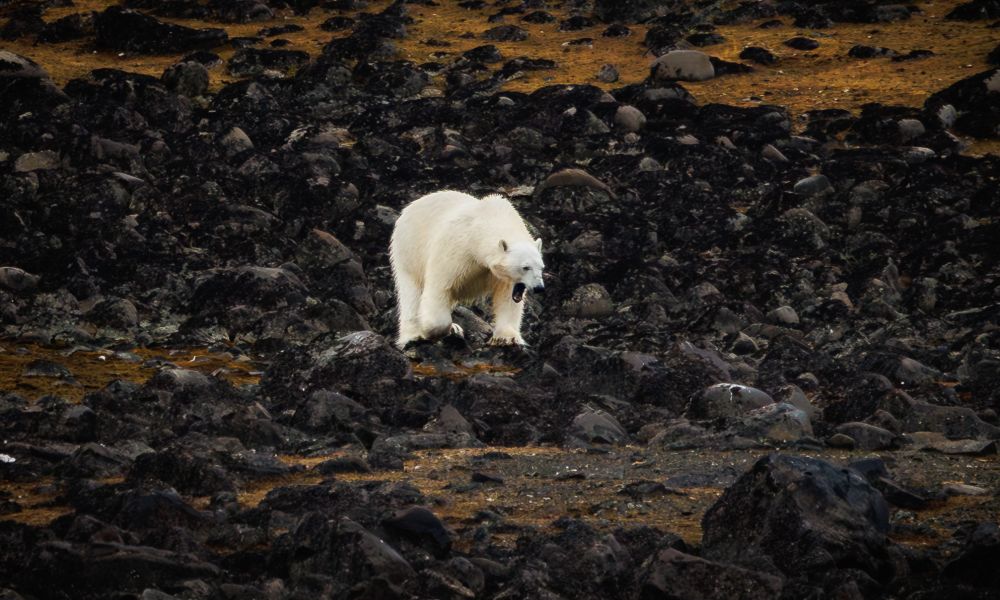
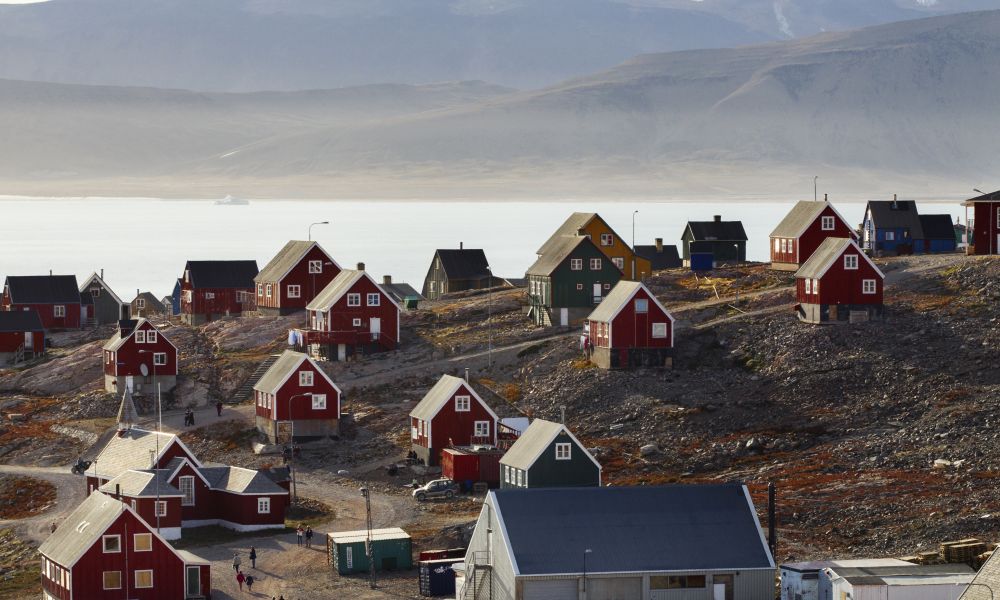
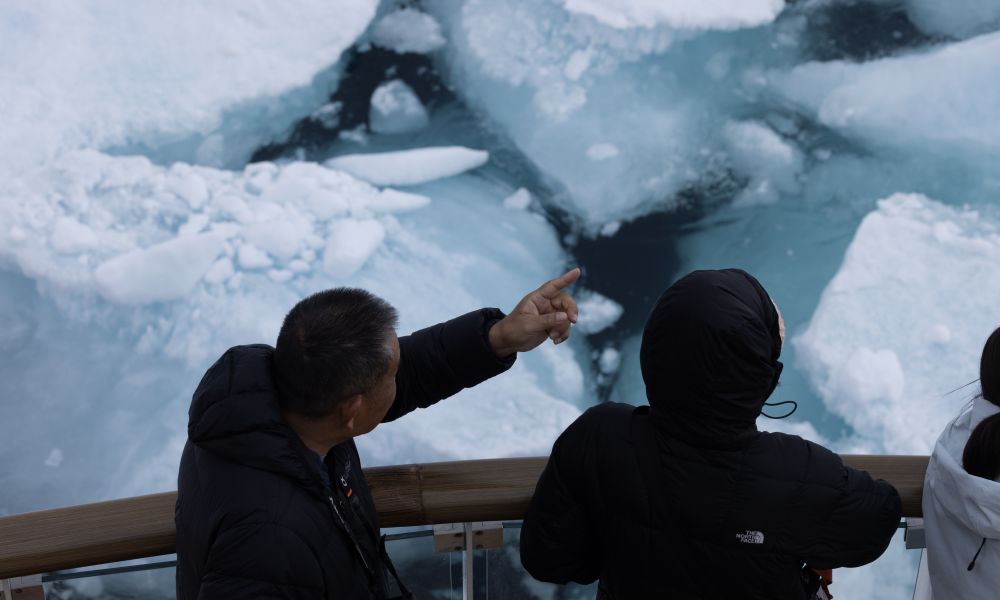
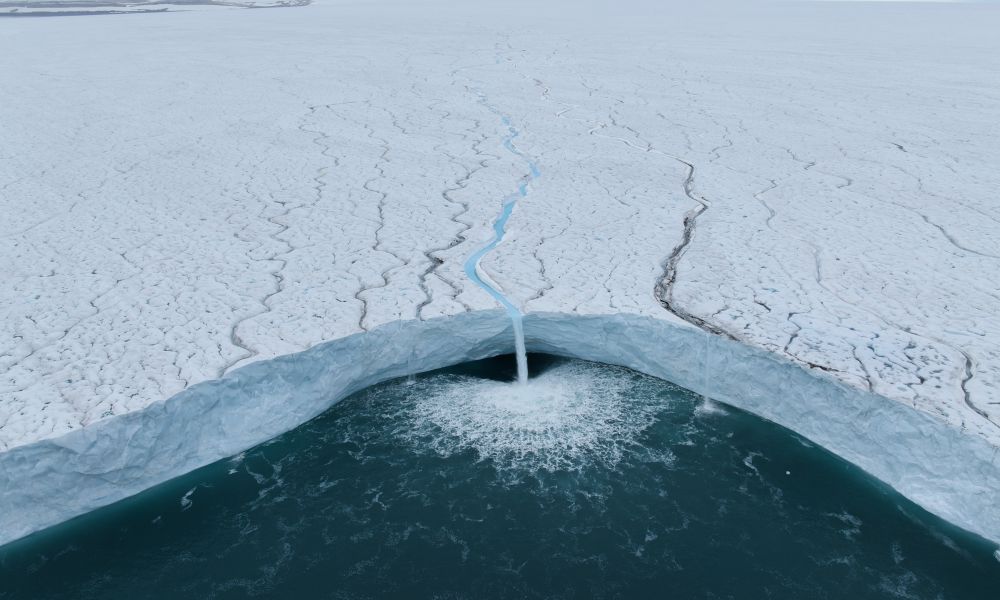
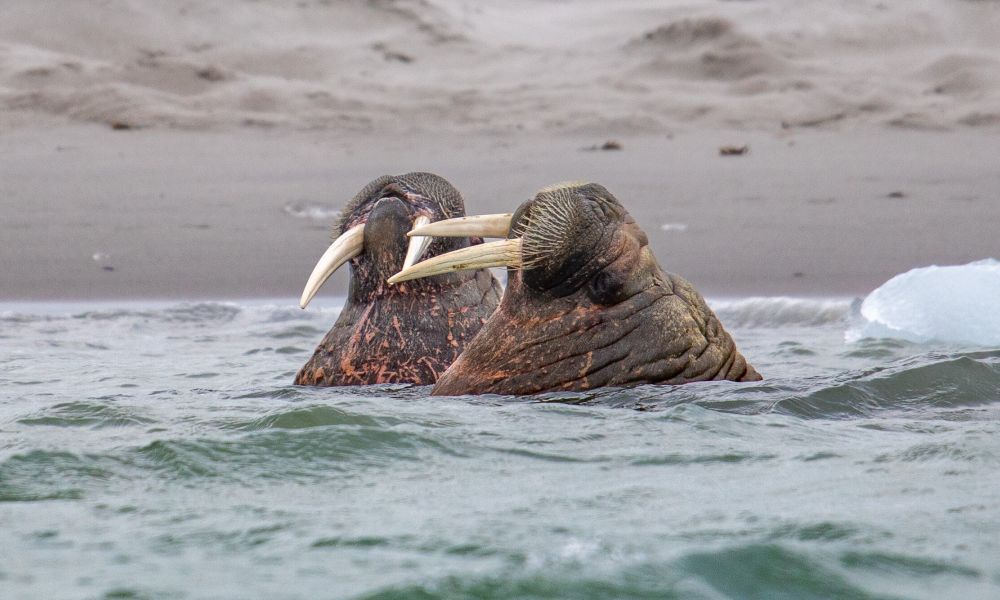
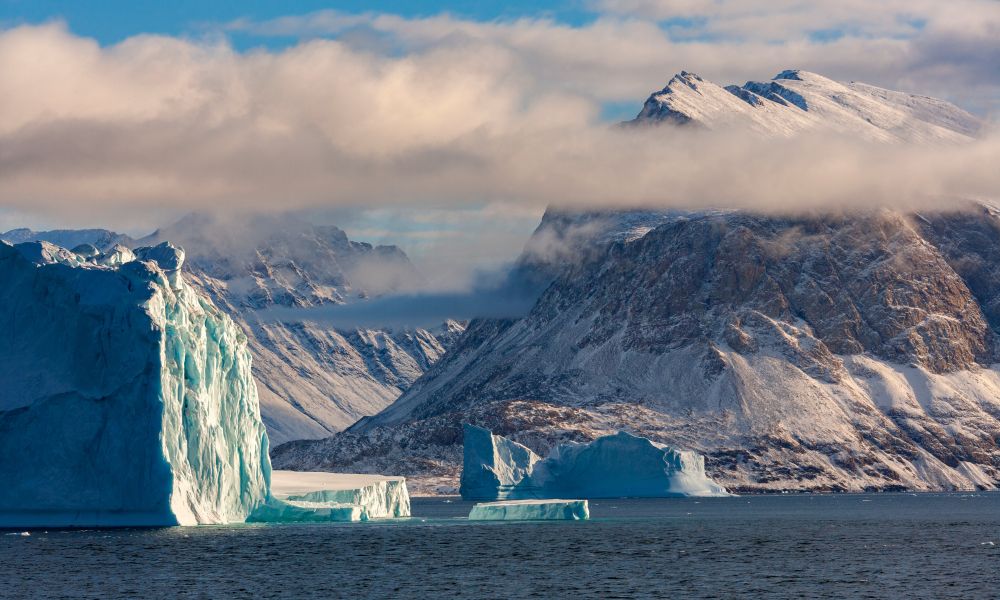
Day 1
Longyearbyen, Svalbard - Embarkation
Board your flight in Norway and arrive in Longyearbyen, Svalbard - the world's northernmost... everything! This remarkable little city is not only the northernmost town in the world (if one excludes the tiny research community of Ny-Ålesund, slightly further north on Svalbard), but also hosts the world's northernmost civilian airport, schools, bank and supermarket. The town's rugged frontier edge belies a core of warm Nordic hospitality and coziness - hyggligt, as we say in Denmark!
Immediately after landing in Longyearbyen, you find yourself in a different world. The chilly Arctic breeze can be felt as soon as you step onto the tarmac, and the famous signpost outside the terminal reminds visitors how far north they really are; as well as to keep watch for bears! The snow-capped mountain Hjorthfjellet looms over the airport on the far side of Adventfjorden, and off in the distance can be seen the saw-toothed peaks and languid glaciers of northern Spitzbergen.
After arrival, you will board the awaiting Ocean Albatros. After our mandatory safety briefing and lifeboat drill, head onto the outer decks to enjoy a glass of champagne while watching your expedition vessel leave civilisation behind... And set a course for adventure!
Day 2
Kongsfjorden Area, Svalbard
During the ‘night’ (what is night, when the sun never sets?), your vessel will have repositioned past the saw-toothed mountains of Prins Karls Forland and arrived in magnificent Kongsfjord. Surrounded by craggy mountains, bounded by the magnificent Kongsbreen and Kongvegen Glaciers, and crowned by the Three Crowns (a set of pyramidal mountains said to represent the monarchies of Norway, Sweden and Denmark), this is surely one of the most beautiful and tranquil corners anywhere in the world.
Our first landing will be at the small settlement of Ny Ålesund. Situated further north than Longyearbyen, Ny-Ålesund is Earth's northernmost settlement, if a group of scientific stations, a post office and a single shop open for a few hours can be described as such... You will have to judge for yourself!
These islands' geographical location has made them the staging post for exploratory and scientific expeditions for centuries - a proud legacy which continues to this day. The setting is spectacular, and the scientific projects are as fascinating as the history of the town, which has hosted the Nobile, the Norge and the Fram, Amundsen, Nansen and Nordenskiöld, all legends of polar exploration who passed this lonely outpost seeking to push the boundaries of humanity. The remnants of these expeditions (such as the mooring mast of the Norge) can still be seen today.
Day 3
Northwest Svalbard
One of the largest protected wilderness areas in Europe, North West Svalbard was declared a national park in 1973. The area is famed for its history, which documents some of the earliest human arrivals on Svalbard. While Norse explorers may have sighted these icy shores during the Viking Age, the first definite arrival was the expedition of William Barents, the legendary Dutch explorer for whom the Barents Sea is named. While now protected from human distruption, when Barents arrived in 1596, he noted the vast numbers of whales and seals which were soon prey to English and Dutch whalers, who arrived within a decade of Barents to pillage the area's wildlife. The area occupied the triple point between land, sea and ice, and as such was the perfect location from which to harvest the gentle giants of the oceans. Sites used to dismember whale carcasses and render them for their precious oil include the Dutch settlement of Smeerenburg, where the remains of 16th Century blubber ovens and building foundations can still be seen. Other sites such as nearby Ytre Norskøya record the darker side of this industrialised slaughter, where hundreds of young men who hoped to make their fortunes are buried thousands of miles from home.
Today, all that remains from this period of history are bones and the scant remnants of human habitation. Slowly reclaimed by creeping Arctic nature, the region is now a nature lovers paradise. Tiny Arctic poppies and purple saxifrage defy the brutal conditions to flower in the brief summer, while geese, eider ducks and other seabirds return to the island to raise their young. Walrus can be found hauled out on beaches, and we must always be on careful lookout for wandering polar bears in this now again wild region.
Day 4
Southern Svalbard
Sailing along the west coast of Svalbard we arrive into the greener warmer regions of this Arctic wilderness. The southwest coast of Svalbard is washed by warmer water coming up through the Atlantic, so winter ice generally retreats first from this region. This allows us to enter the southern fjords of Svalbard - easily some of the most spectacular regions of this stunning archipelago.
Throughout this maze of fjords and islands, birds cluster together on high cliffs and reindeer graze on the fertile slopes below, while icebergs drift by from the various large glaciers in the area. Tiny calico snow buntings flit between crags, while perfectly camouflaged purple sandpipers scamper along the shore. Look higher up on the vegetated slopes, and there - greyish white 'boulders' move and resolve themselves into sheep-sized reindeer: the unique subspecies native to Svalbard. A flash of bluish-black, and the screeches of nearby birds herald the arrival of the Arctic fox, the only native land predator on Svalbard (the polar bear being classified as a marine mammal).
The mountaintops are most often covered by dense clouds and the East-Spitsbergen current often leads pack ice into the mouths of the fjords. With a huge variety of landing sites to explore, this region is without doubt one of the most exciting and diverse regions of Svallbard! Options to explore in the area include the huge bird cliffs of Gnålodden and Vårsolbukta, and the historical sites of Calypsobyen and Bambsebu, where prospectors, trappers and a range of other adventurers attempted (and largely failed) to make their fortunes.
From Southern Svalbard, our vessel will strike out into the chilly waters of the Greenland sea, en route to Scoresbysund, Earth's largest fjord system.
Days 5 - 6
Across the Greenland Sea
Leaving Svalbard behind, we venture across the Greenland Sea, the frigid waters separating Svalbard and Northeast Greenland. This body of water is among the most productive in the world, where the cold polar East Greenland Current collides with the warm northbound Gulf Stream. These nutrient-rich waters support vast stocks of fish, and the humans, seals, whales and seabirds which rely on them.
Days at sea are never dull. We will arrange a variety of activities onboard for our guests to enjoy to engage the mind, body and soul. Join your knowledgeable Expedition Team lecturers in the Theatre to hear specially-crafted lectures on Arctic history, wildlife, geology, culture and more, unwind with a massage in the Albatros Polar Spa, or simply watch the seabirds gliding along the ship from our hot tubs as we fly across the Greenland Sea towards adventure in Greenland.
Day 7
Ittoqqortoormiit, East Greenland
The only settlement in the vast wilderness of Northeast Greenland is Ittoqqortoormiit (meaning 'the People who Live in Big Houses), which surely ranks among the most remote communities on Earth. As the name suggests, the town is relatively new, having been established by Danish authorities in 1925. Colonists were relocated from the Ammassalik region further south in response to what were seen as poor living conditions in the area, as well to establish Danish sovereignty in the region during a territorial dispute with Norway. While the establishment of the town was challenging, the settlers soon realised the region was hugely rich in game, with excellent hunting and trapping opportunities. This tradition continues to this day - the majority of residents continue to live a subsistence hunting lifestyle, essential in a town where supply ships arrive only once or twice each summer. The only access to the outside world is via the heliport to the nearby airport, from where small aircraft depart for Iceland.
Ittoqqortoormiit is a town with a strong sense of community and traditional culture, where foreigners are welcomed warmly. The town hosts an excellent museum, a beautiful traditional Greenlandic church, and locals often welcome visitors to their community wearing colourful traditional costumes. The town represents a wonderful introduction to the culture and lifestyle of Northeast Greenland, in one of the most spectacular natural locations anywhere in the world.
Days 8 - 11
Scoresbysund, East Greenland
Entering Scoresbysund, Earth's largest and longest fjord system, one could be forgiven for not realising this huge 35km inlet is a fjord at all! Scoresbysund is named for English whaler and explorer William Scoresby, one of the first Europeans to map this region; the local name for this vast fjord system, Kangertittivaq, is a typical Greenlandic understatement, roughly meaning 'The Rather Large Fjord'.
The program for our days in the National Park depends on wind, sea, weather and ice conditions. In such a remote region so far north, Mother Nature dictates all human activity. Our exact route and activities will be determined by the Captain and the Expedition Leader jointly and are typically announced the night before. Opportunities to explore here are endless, in a region brimming with staggering views, fascinating history and incredible wildlife encounters.
Perhaps we will visit the islands of Bjørne Øer, a maze of saw-toothed islands and waterways almost purpose-made for Zodiac cruising. Maybe we will set foot on the tundra meadows of Jyttehavn, beneath the looming peaks of Grundtvigkirken Mountain. The sea may lead us towards the vast glaciers of Vikingebugt and Månegletscher, or to the ancient Inuit archaological sites of Sydkap, or the old buildings of Gurreholm, which almost drip with history. Perhaps we will marvel at the glaciers creeping down from the mountains of Milne Land, or witness the breathtaking mosaics of sea ice which are the habitat of seals and polar bears, or cruise through icebergs the size of small cities.
Wherever we go in Scoresbysund, the senses are spoiled with stunning views, pristine Arctic nature and crisp clear air carrying the scent of tundra and ice. Natural wonders and a sense of global perspective are guaranteed!
Day 12
Ísafjörður, Iceland
Nestled deep in the Westfjords of nothwest Iceland lies the town of Ísafjörður, the largest town in the region, and unofficail 'capital' of the Westfjords. Ísafjörður means 'Icy Fjord' in Icelandic, hinting at the area's extreme climate characterised by strong winds and brutal winters, which has limited human habitation in the region since its discovery. The fjord was settled by Viking explorers in the 9th Century, Scandinavian pioneers who sought farmable land far away from oppressive lords on the mainland. The modern town was established as a trading post in the 16th Century; like many small Icelandic towns, Ísafjörður boomed on fish exports, and the town's economy remains centered on it's excellent natural harbour to this day.
Ísafjörður is a welcoming town with excellent amenities, and a popular destination for modern day Arctic explorers, who come to experience the nature which is easily accessible from town. The town's small center is crammed with hip cafes selling delectable sweet treats, galleries packed with stunning pieces produced by local artisans and restaurants specialising in the area's exquisite seafood. If urban exploring isn't your thing, take a stroll out of town to explore some of the best scenery in Icealnd. The surrounding mountains are not for the faint-hearted, but offer excellent opportunities to immerse yourself in Arctic nature, which here has a very different character to Greenland and Svalbard. In place of the granite fells of Greenland are the sweeping basalt mountains typical of this volcanic island, and the knee-high forests which cling to life on south-facing slopes.
As we depart Ísafjörður towards Reykjavik, our guests have the ideal chance to reflect on their Arctic adventure. Relax with an expertly crafted cocktail in the Nordic Bar in the company of new friends, soak up the knowledge and passion of our Expedition Team during their lectures, or simply enjoy the flight of the fulmars which accompany us towards Reykjavik.
During your last evening onboard, join the Captain and Officers for the Farewell Cocktail Party, followed by a presentation of photos and video by our onboard photographer - the ideal opportunity to re-live your Arctic adventure. Skål!
Day 13
Reykjavik, Iceland - Disembarkation
As the Icelandic capital comes into view on the horizon, strange objects appear: trees larger than ankle height, glassy skyscrapers and streets full of cars, busses and people... Such a bustling capital may feel strange after the remote wilderness of the High Arctic!
After a hearty breakfast, it is time to bid a fond farewell to the Crew and Expedition Team of Ocean Albatros, and descend the gangway back to dry land with memories of the voyage of a lifetime.
Inclusions
- 13-day/12-night cruise in a shared outside double room with a private bathroom in the category chosen
- English-speaking expedition staff
- Guided walks with the expedition team
- Nature hikes and Zodiac cruises per itinerary
- Information briefings and lectures by the expedition team
- Transfers to/from the vessel in Longyearbyen
- Activities in certain towns, as per itinerary
- Full board on the ship
- Dinner drink package
- Free coffee, tea, and afternoon snacks on the ship
- Welcome and farewell cocktails
- Taxes, tariffs, and landing fees
- Digital visual journal link after the voyage, including voyage log, gallery, species list, and more
Exclusions
- Extra excursions and activities not mentioned in the itinerary
- Single room supplement and cabin upgrades
- Meals not on board the ship
- Beverages (other than coffee and tea and dinner-drink package)
- Tips for the crew (we recommend USD 16 per person per day)
- Personal expenses
- Transfers to/from the ship in Reykjavik
- Travel, cancellation, and medical insurance
- Anything not mentioned under ’Inclusions’
After leaving Longyearbyen, your expedition vessel will proceed onwards into the wilderness to explore the unknown. The goal for the days spent exploring is to offer activities which will allow everyone to explore off the ship as much as possible, and experience the nature, history, wildlife and culture of the Arctic in person.
Our activities will vary widely according to the nature of the locations we visit – some larger settlements need an entire day to explore, whereas some smaller nature sites can be seen in a few hours. The Arctic is vast and travel time between destinations can be significant. Activities we offer include landings, Zodiac cruises and ship cruises. Regulations in the Arctic limit the number of people ashore at any time at certain natural and historical sites, so we will usually aim to offer a Zodiac cruise while our first group of guests are ashore, and reverse this for the second group ashore to maximise exploration time where numerical limits apply. In towns and cities where the environment is less sensitive, there are no limits on numbers of people ashore. No matter the day’s planned activities, the onboard Expedition Team and Expedition Leader will work as hard as possible in conjunction with the Captain and Crew to maximize exploration opportunities.
A “typical” expedition day in Greenland and Svalbard may look like this (subject to weather and sea conditions and sailing schedule):
- 0645: Wake-up call
- 07.00-08.00: Breakfast
- 08.30-11.30: Morning activity – arrival in port at anchor, Zodiac ashore to explore settlements, historical sites, joing Zodiac cruises etc. Depending on the location, we may spend the whole day in port.
- 12.30-13.30: Lunch onboard
- 1430-17.30: Afternoon Activity – Either in connection with the morning, or at a different site, depending on itinerary
- 18.30-1930: Evening Recap with Expedition Team
- 19.30: Dinner
Landings are a great opportunity to stretch your legs and set foot on shore to experience the Arctic nature first-hand. Our experienced Expedition Team will be on shore to help you spot any wildlife, identify the different species of birds and mammals, guide you through settlements, as well as keep our guests safe on shore from any potential hazards.
We remind our guests that this is a truly wild destination, to consider their physical capability when travelling to the Arctic. In smaller towns and villages, infrastructure for tourism may be less well developed than in other destinations. Most smaller towns and villages lack step-free access, and roads and paths can often be steep and uneven. Outside settlements, visitors should not expect infrastructure of any kind, although such locations offer the chance to experience the raw beauty of the Arctic tundra up close and personal.
Some sites do not offer landing opportunities, but are locations where exploring on the water offers the best opportunities for sightseeing, wildlife and photography. These Zodiac cruise sites are often known for their concentration of ice, wildlife and even historical landmarks, where our fleet of Zodiacs offer the best vantage point. This would be the only scenario you may have to wait on the ship (other than in adverse weather conditions), but we will always aim to offer an onboard program during this time, such as seminars given by our knowledgeable and experienced Lecturer team. Zodiac cruises are great for observing icebergs, glaciers, whales, and other marine wildlife. Your skilled driver will navigate around the area looking for wildlife and beautiful landscapes. By the end of the voyage, Zodiac cruises tend to become a firm favourite among our guests because of the vast diversity of scenery and marine life it is possible to experience.
In the event we encounter bad weather or are in a particularly spectacular location, often our purpose-built expedition vessels are the best viewing platform. The Captain and Expedition Leader will search for locations best accessed with the vessel to seek out the best wildlife and scenery. We encourage everyone to bundle up and either head onto the outer decks with the Expedition Team or relax in superlative comfort in our specially-designed lounges to experience the majesty of the Arctic from the best vantage point. During this time, our Expedition Team specialists will offer skillfully-crafted lectures related to the wildlife, history, culture and conservation of the region, and more!
Other activities onboard include our ship Gym, where you can burn some calories on our fitness bicycles or treadmills; most of our ships even have other cardio machines and strength/lifting options. Most voyages throughout the season also offer kayaking (booked and paid onboard – weather permitting), and we will often aim to offer hiking excursions onshore when possible. Our new purpose-built ships have a Spa, in which guests can enjoy massages, facials, and other relaxing treatments (additional cost applies). Our Library is a great place to rest between outings, with expansive views and a wide selection of Arctic-related reading material. During your voyage you will also be able to enjoy our tea time in the late afternoon, or indulge in some retail therapy in our onboard shop, which sells personal necessities as well as specially-selected Arctic souvenirs.
In between our landings and activities we offer three hearty daily main meals. Albatros Expeditions always have allergy flexible options, healthy selections as well as a variety of vegetarian and vegan options.
Our hardworking galley crew deliver multiple Breakfast options, served in a buffet style along with a cooking station where eggs are made to order. At Lunch we are also met with a smorgasbord of mouthwatering choices. Safe to say you will have the energy for your next outing!
When it is Dinner time, you can choose to eat at the main restaurant or book a table at the Specialty Restaurant. Your evening meal is served a la carte, with fresh new options daily and always a selection of fixed items. There is always a vegetarian and pescetarian option available. Albatros Expeditions are known for our delicious menus and a variety of exquisite wine pairings.
Onboard you will also have the option to join Afternoon Tea with sweet treats, cakes or snacks served each afternoon. Albatros Expeditions have tea and coffee freely available all day throughout the vessel, while specialty coffee, alcoholic beverages and hand-crafted cocktails are available at the ship’s bars.
Spring comes late to Greenland and Svalbard, due to their challenging polar climate. During June, migratory wildlife begins to return to the Arctic. Geese, wading birds, and seabirds arrive for their breeding season, constructing nests and defending their tiny but all-important territories. While Greenland and Svalbard experience the midnight sun from May to August, during June, many of the fjords are still frozen, and snow reaches down to the sea. This cold and unpredictable weather can hamper exploration at times.
By July, the Arctic begins to come to life. The tundra begins to bloom, as saxifrages, Arctic willows and heathers start to green the otherwise stark Arctic landscape. Flowers bloom in the brief Arctic summer, rotating through the day to follow the precious sunlight. In wilderness areas, muskox and reindeer can be seen grazing on the fresh greenery, while inhabited locations burst to life. Locals in Greenland take advantage of the brief summer to harvest the ocean’s riches, and summer is prime fishing season. Conditions during July tend to be settled, with calm sunny days the norm (although beware of the mosquitos in windless areas)! Expect to meet plenty of locals – July is the middle of the summer holiday, so expect to see Greenlandic children enjoying their freedom on their bikes and skateboards. Many locals pivot to working in tourism during the brief summer season; even small towns can be bustling when a vessel visits!
August is the peak of the Arctic summer, with long sunny days – although the evenings start to draw in, with several hours of darkness by the end of the month. August is prime hunting season in Greenland – depending on the day, some settlements can be almost empty, with almost all locals heading into the wilderness to hunt reindeer, seals and muskox. Expect to see the fruits of these hunts for sale in local markets, usually proudly sold by local hunters. August is also peak trout season, so expect to see fish hung up to dry around towns and villages, or being smoked in small turf ovens. Most chicks on the bird cliffs of Svalbard have begun to fledge by this point, and are starting to leave the nest; for cliff-nesting species, this involves a terrifying leap off their nest into the sea – often known as ‘jumping season’. On land, the tundra plants are moving rapidly through their life cycle, and tart crowberries and delicious blueberries are almost everywhere – expect to see locals young and old alike gathering this delectable bounty; some is eaten as-is or used in baking, and the rest frozen to enjoy during the long winter.
The tundra is at its brightest during September, as the willows, then the saxifrages and heathers begin to show their autumn colours; an autumn forest in miniature! During September, the weather in the North Atlantic can become more challenging and wild, giving an even more rugged cast to this spectacular island. September marks the return of true dark nights to Greenland and Svalbard as autumn sets in. Frosts and even snow showers can occur this time of year, although the longer nights also offer a tantalising chance to see the Northern Lights. This time of year, most migratory birds are starting to head south or out to the open ocean for the winter, so expect to see a variety of birds of all ages heading to sea for winter.
Albatros Expedition strives to employ the very best Expedition Team in the whole industry. We travel in some of the planet’s most remote regions, where planning and on-location experience is key. Our routes and itineraries are subject to the prevailing sea, ice and wind conditions, which are closely monitored by the Bridge Team and Expedition Leader. Drawing on their vast experience, they find the best alternatives in the rare instances where our planned itinerary needs to be changed. Each cruise is a completely unique combination of locations, where the highlights can often be the totally unexpected. Most of our cruises provide the opportunity to spot a variety of unique wildlife, although this is subject to the whims of Mother Nature and can of course not be guaranteed. As you will no doubt experience, the joy from our Expedition Team when spotting different species on land or at sea is as genuine as your own.
This means that you as our guest are part of an adventure, a true expedition, where plans change, wildlife is encountered on their terms and your team consists of the very best experts within their fields. We strive to maintain a mix of specialists within relevant polar subjects including marine biology, ornithology, earth science, history and others. Albatros Expeditions boast a large number of Expedition Staff onboard, allowing us to maintain a high ratio of staff-to-guests at 1:8, amongst the highest ratios in expedition cruising. Some of our staff have decades of experience on ships or research stations, whilst others may be performing their first season. One thing they all have in common is the wish to make each and every journey a special and memorable experience for our guests. Knowledge, skill, and passion are the trademarks of all Albatros Expedition Staff.
To ensure the safety and quality of experience of our guests, please keep in mind that the itinerary and outdoor activities during each voyage are solely dependent on weather and sea conditions. Your safety is our highest priority. The route and shore landings will be determined by the Captain and Expedition Leader and communicated to guests through regularly scheduled briefings. Albatros Expeditions reserves the right to modify the landings and locations visited during a voyage based on local weather conditions and climate to ensure a safe and enjoyable experience for all our guests. Our voyages are expeditionary in nature, and thus changes to timings are commonplace due to the environment we operate in, as well as wildlife opportunities and locations.
Arctic weather is famously unpredictable. Svalbard experiences midnight sun from April to late August, bringing with it warmer and calmer weather. Summer temperatures tend to range between 4-10°C (39-50°F); due to the constant sunlight, temperatures in summer rarely drop below freezing, although frost and snow showers can occur at any time.
Extended periods of sunshine can warm up sheltered areas significantly, and these can feel warm (even hot) on calm windless days. However, the weather in Svalbard is heavily influenced by the last gasp of warm water currents from the Gulf Stream, which can bring rapidly changing conditions. Fog, wind and rain can occur at any time, even on the warmest sunniest days, leading to rapid drops in temperature.
East Greenland differs significantly from the rest of the country; here, a current of cold water flows down from the Arctic Ocean, moderating the temperature. Temperatures in East Greenland are therefore cooler than at the same latitude on the west coast, with summer temperatures in Ittoqqortoormiit averaging 5-9°C (41-48°F). East Greenland receives significantly more snow in the winter than the west – street lights in Ittoqqortoormiit are built a metre higher than in the rest of the country to account for this. During late spring, East Greenland also regularly receives rafts of sea ice from the Arctic Ocean, which can linger for several months, cooling the area.
We therefore remind our guests to be prepared for all weather conditions! We highly recommend to our guests to dress in layers (ideally in woolen or synthetic fibers) and a backpack so that layers can be adjusted as the weather dictates. Warm/waterproof layers, hats, waterproof gloves and scarves are recommended for all excursions off the vessel, even on the sunniest days – the weather can deteriorate rapidly at any time. Sun protection (hats, sunglasses, sunscreen and lip balm) is also essential – the low angle of the Arctic sun combined with cool ambient temperatures can cause sunburn to easily go unnoticed until it is too late!



